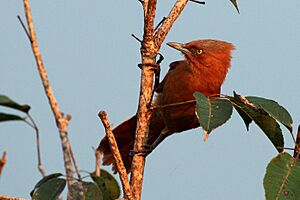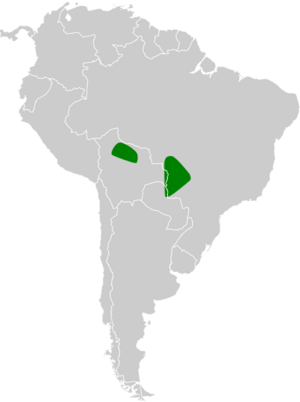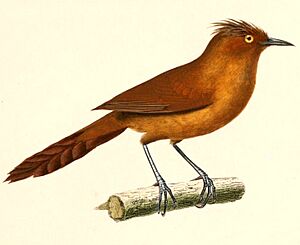Grey-crested cacholote facts for kids
Quick facts for kids Grey-crested cacholote |
|
|---|---|
 |
|
| In the Pantanal, Brazil | |
| Conservation status | |
| Scientific classification | |
| Genus: |
Pseudoseisura
|
| Species: |
unirufa
|
 |
|
| Synonyms | |
|
Pseudoseisura cristata unirufa |
|
The grey-crested cacholote (Pseudoseisura unirufa) is a type of bird. It belongs to the ovenbird family called Furnariidae. You can find this bird in parts of Bolivia, Brazil, and Paraguay.
Contents
About This Bird's Name
Scientists group living things into families and species. The grey-crested cacholote is a unique species. It used to be considered a part of another bird, the Caatinga cacholote. That bird was once called the rufous cacholote.
In 2000, new information showed they were different species. So, scientists decided to split them. It can be a bit confusing because some people still call the grey-crested cacholote the "rufous cacholote."
What Does This Bird Look Like?

The grey-crested cacholote is about 20 to 21 cm (7.9 to 8.3 in) long. That's about the length of a ruler! It weighs between 42 to 57 g (1.5 to 2.0 oz). This is like weighing a few chocolate bars.
It is a fairly large bird with a noticeable crest on its head. Both male and female birds look the same. Their bodies are mostly a bright reddish-brown color. This color is a bit lighter on their bellies.
Their crest can be reddish-brown or mostly grayish. The middle of their throat often has a hint of orange. Their eyes are yellow. Their beak is blue-gray, and their legs are olive-greenish gray. Young birds have a shorter crest. Their colors are also less even than adult birds.
Where Does This Bird Live?
The grey-crested cacholote lives in different areas. One group lives in north-central Bolivia. Another group is found in southeastern Bolivia, parts of Brazil, and northern Paraguay.
These birds like to live in gallery forests. These are forests that grow along rivers. They also live in woodlands and savannas that flood during certain seasons. You can often spot them near human homes. They usually live at elevations between 300 and 500 m (980 and 1,640 ft).
Behavior
How This Bird Moves
The grey-crested cacholote stays in its home area all year long. It does not migrate to other places.
What This Bird Eats
Scientists are still learning a lot about what the grey-crested cacholote eats. They think it mostly eats arthropods. These are creatures like insects and spiders. It might also eat some fruits and seeds.
These birds usually look for food in pairs. They often search on the ground. They pick up food, poke into the soil, and even dig for their meals.
Reproduction and Nests
The grey-crested cacholote is believed to stay with one partner for life. They likely breed during the spring and summer months in the southern hemisphere.
Their nest is a large pile of sticks and branches. It is usually twice as long as it is wide. They add feathers, shells, bones, and other items to the nest. The nest is typically built in a tree, about 4 or 5 m (13 or 16 ft) above the ground.
The nest has a special entrance tunnel near the bottom. This tunnel leads to an inner room. This inner room is lined with pieces of bark and snake skin. Scientists do not yet know how many eggs they lay. They also don't know how long the eggs take to hatch or when the young birds leave the nest.
What Sounds Does This Bird Make?
The grey-crested cacholote often sings with its partner. Their song is loud and speeds up. It sounds like "chew" notes mixed with chattering and rattles. The song finishes with a cackling sound. Their call is a single "chuk" sound.
Status
The IUCN (International Union for Conservation of Nature) has looked at the grey-crested cacholote. They have decided it is a species of "Least Concern." This means it is not currently in danger of disappearing.
It lives across a large area. Its total population size is not known, but it seems to be stable. Scientists have not found any immediate threats to this bird. While it's not super well-known, it is common around ranches and other human buildings.


